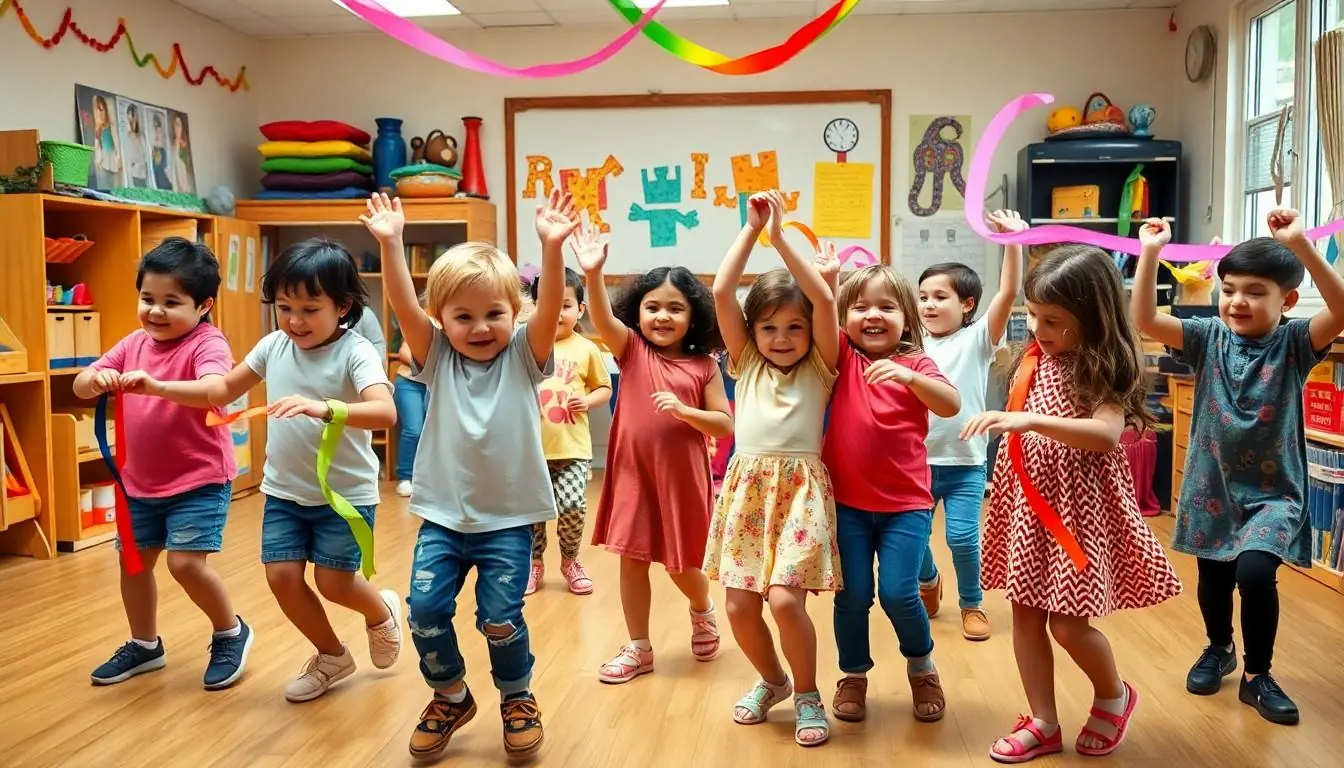Imagine a room full of giggling preschoolers, their tiny bodies bouncing to the beat of a catchy tune. Music and movement activities aren’t just fun; they’re essential for developing young minds. These activities spark creativity, improve coordination, and even boost social skills. Who knew that shaking maracas and dancing like nobody’s watching could be the secret recipe for a well-rounded preschool experience?
Table of Contents
ToggleImportance Of Music And Movement Activities For Preschoolers
Music and movement activities play a vital role in preschoolers’ overall development. Engaging in these activities nurtures various skills crucial for their growth.
Cognitive Development
Cognitive development benefits significantly from music and movement activities. Children enhance their memory and attention skills by participating in rhythmic games and songs. Opportunities to explore patterns and sequences foster critical thinking. Engaging with instruments or clapping to different beats encourages auditory skills. This interaction creates a foundation for language development, as music often incorporates storytelling. Implementing these activities strengthens problem-solving abilities through creative expression.
Physical Development
Physical development receives a considerable boost from music and movement activities. Engaging in dancing and structured movement enhances gross motor skills, strengthening coordination and balance. Active participation in rhythm games improves body awareness and spatial orientation. Simple activities like jumping, spinning, or marching develop muscle control and endurance. Frequent movement encourages overall health and fitness, promoting an active lifestyle in young children. These physical experiences lay the groundwork for further athletic pursuits in later years.
Social And Emotional Development
Social and emotional development thrives through music and movement activities. Collaborative games foster teamwork, teaching children how to interact with peers positively. Joining in group music sessions helps kids express their emotions effectively. Sharing instruments and dancing together builds trust and strengthens friendships. Engaging in this creative process also boosts self-esteem, as children gain confidence in their abilities. These shared experiences create a sense of belonging, essential for emotional growth in preschoolers.
Types Of Music And Movement Activities
Music and movement activities encompass various interactive experiences tailored for preschoolers. These activities promote fun and enhance multiple aspects of development.
Dancing Games
Dancing games encourage physical engagement and creativity. Children respond to different music styles, allowing them to explore movements freely. Games like Freeze Dance stimulate coordination, as participants freeze when the music stops. Regular participation enhances motor skills and rhythm recognition. Various props, such as scarves or ribbons, add real excitement, fostering imaginative play.
Rhythm Exercises
Rhythm exercises play a crucial role in developing listening and coordination skills. Clapping hands, tapping feet, or using simple instruments, such as tambourines, helps children internalize beats. Incorporating body percussion techniques, like stomping or snapping, enhances engagement and promotes group dynamics. These activities create a fun atmosphere while improving concentration and memory capabilities.
Musical Storytelling
Musical storytelling offers a unique way to combine imaginative play with music. By integrating songs into narratives, children develop listening skills and imagination. Using instruments to represent characters or actions adds an interactive element to storytelling. Activities like acting out a story with music encourage creativity and self-expression, benefiting language development and comprehension.
Benefits Of Integrating Music And Movement
Music and movement activities yield numerous developmental benefits for preschoolers. These activities not only entertain but also foster essential skills that contribute to children’s growth.
Enhancing Motor Skills
Movement activities improve gross and fine motor skills. Dancing, running, and hopping strengthen coordination and balance. Physical activities like these develop core strength and body awareness. Organized games, such as obstacle courses, provide opportunities to practice various movements. These experiences help children gain confidence in their abilities and refine their physical control. By engaging in rhythmic activities, children learn timing and coordination. Music encourages repetition, allowing kids to enhance their motor skills in a playful manner.
Encouraging Creativity
Integrating music stimulates creativity within preschoolers. Expressive movement allows children to explore their imaginations. Using props and instruments during musical storytelling promotes innovative thinking. Children enjoy improvising dance routines, leading to self-expression and artistic exploration. Music’s rhythmic nature encourages kids to invent their own tunes and beats. This process enriches their ability to think divergently. Participation in music and movement helps develop a love for creative expression, instilling joy in the process of creating and discovering.
Promoting Cooperation
Cooperative music and movement activities encourage teamwork among preschoolers. Working together during games fosters social interaction and builds lasting friendships. Children learn to share space, wait for their turn, and communicate effectively. Group activities like circle dances require collaboration, enhancing their interpersonal skills. The shared experience of creating music develops empathy and understanding. Participation in teamwork-oriented activities builds trust and a sense of belonging. With ongoing engagement, young children cultivate skills essential for future social settings.
Tips For Implementing Activities
Implementing music and movement activities effectively encourages preschoolers’ development. These tips streamline the process for educators.
Choosing Appropriate Music
Selecting the right music is essential. Opt for songs with simple rhythms, catchy melodies, and engaging lyrics. Preschoolers respond well to genres like children’s folk songs and upbeat pop tracks. Consider including diverse cultural music to broaden children’s exposure. Play songs that promote movement, like those with clear cues for actions. Familiar tunes enhance participation, as kids enjoy singing along. Regularly updating the playlist keeps the activities fresh and exciting.
Creating A Safe Environment
A safe environment ensures children can explore movement freely. Arrange the space to minimize hazards, clearing away obstacles that could cause falls. Use soft mats or carpeting to cushion landing and prevent injuries during dance activities. Designate specific areas for different activities to enhance focus and organization. Provide clear instructions so children understand boundaries while engaging in movement. Monitoring activities in real-time allows for immediate intervention when necessary. Strengthening safety measures promotes confidence as children play and express themselves.
Engaging Parents And Caregivers
Engaging parents and caregivers strengthens the music and movement experience. Encourage families to participate during special events or showcase performances. Provide resources, such as playlists or activity guides, so they can join in at home. Share the developmental benefits of these activities through newsletters or workshops to foster understanding. Encouraging parents to play music and move together reinforces concepts learned in class. Building a partnership ensures continuity between home and school, contributing to children’s growth.
Conclusion
Music and movement activities are essential for preschoolers’ holistic development. They not only foster creativity and coordination but also enhance social skills and emotional well-being. By engaging in these activities, children learn to express themselves while building trust and friendships with their peers.
Incorporating a variety of music and movement experiences can create a dynamic classroom environment that supports cognitive, physical, and social growth. Educators can make a significant impact by thoughtfully selecting music and creating a safe space for exploration.
Ultimately, these activities lay a strong foundation for lifelong learning and development, ensuring children are well-prepared for future challenges.



